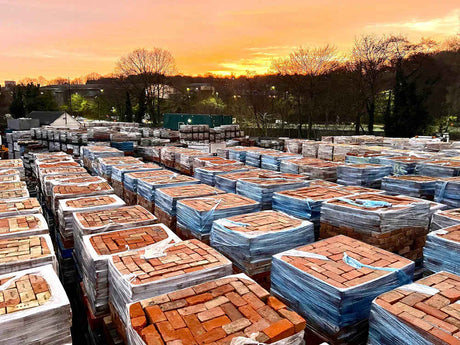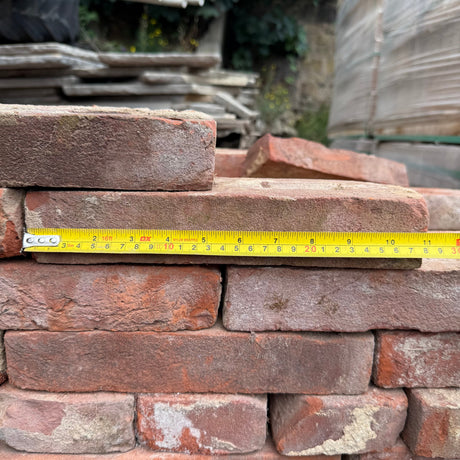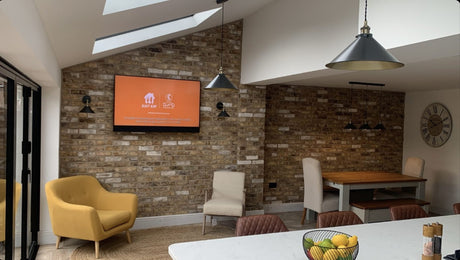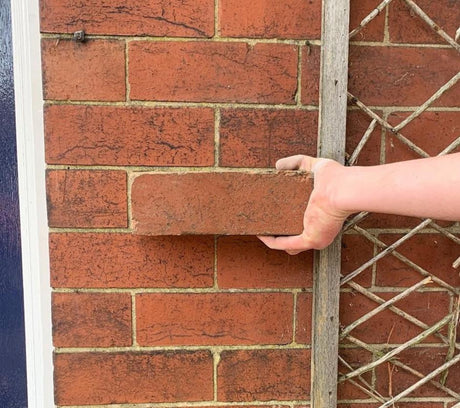Reclaimed Building Materials: An Eco-Friendly Choice
In recent years, sustainable materials and green building practices have become increasingly popular in the construction industry. As the world becomes more conscious of climate change and environmental impact, it is essential to consider alternative building materials that minimise our carbon footprint and promote a more sustainable future. One such solution is the use of reclaimed building materials, which give new life to old, discarded resources. In this blog, we will explore the rise of reclaimed building materials, their benefits, and the impact they have on our environment. We will also delve into different types of reclaimed materials, their unique characteristics, and how they add character and functionality to construction projects. Let's take a closer look at why reclaimed materials are an excellent choice for those seeking to build in an eco-friendly and sustainable manner.
The Rise of Reclaimed Building Materials
In recent years, there has been a significant shift towards sustainable materials and green building practices in the construction industry. This change is driven by a growing awareness of climate change and the need to reduce our environmental impact. Reclaimed building materials have emerged as a key solution in this movement towards sustainability. These materials are sourced from existing structures or materials that would otherwise be discarded, giving them a second life and reducing the demand for new resources. By incorporating reclaimed materials into construction projects, builders can reduce their carbon footprint and contribute to a more sustainable construction industry.
Understanding Reclaimed Materials
Reclaimed materials are building materials that have been salvaged or repurposed from existing structures or materials. They offer a more sustainable alternative to traditional construction materials by utilising renewable resources and reducing the need for new materials. Reclaimed materials can include wood, steel, glass, and other components found in buildings. By repurposing these materials, we can minimise waste, conserve resources, and reduce the environmental impact of construction projects. Reclaimed materials are a key component of environmental design, which prioritises sustainable living practices and the use of materials that have a minimal impact on the environment. Using reclaimed materials not only helps reduce waste but also contributes to the preservation of natural resources, making it a sustainable choice for construction projects.
Why Choose Reclaimed Materials?
When considering building materials, it is important to take into account their environmental impact. Reclaimed materials offer an excellent choice for those seeking to reduce their carbon footprint and make more sustainable choices. By using reclaimed materials, we can minimise waste, conserve resources, and reduce the environmental impact of construction projects. Beyond their environmental benefits, reclaimed materials also offer unique characteristics, durability, and aesthetic appeal, making them a perfect choice for those looking to add character and functionality to their builds. Choosing reclaimed materials supports sustainable forestry practices, reduces greenhouse gas emissions, and promotes a greener future. So, if you're looking for sustainable building materials, reclaimed materials are an excellent choice to consider.

Different Types of Reclaimed Building Materials
Reclaimed building materials come in various forms, each with its own characteristics and potential uses. Let's take a closer look at three popular types of reclaimed materials: reclaimed wood, recycled steel, and repurposed glass. These materials offer distinct benefits, contribute to sustainability, and can be used in various construction applications. Whether it's reclaimed wood for wall cladding or flooring, recycled steel for structural integrity and energy efficiency, or repurposed glass for aesthetic appeal and natural light, incorporating reclaimed materials into your build can enhance its sustainability and contribute to a greener future.

Reclaimed Wood: An Eco-friendly Alternative
Reclaimed wood is one of the most popular choices for those seeking eco-friendly building materials. It offers a natural and timeless elegance that can enhance any construction project. Here are some key features and benefits of reclaimed wood:
- Reclaimed wood helps reduce deforestation and supports sustainable forestry practices, adhering to the standards set by organisations like the Forest Stewardship Council (FSC).
- It can be used for wall cladding, flooring, and various other applications, adding warmth and character to the space.
- Reclaimed wood offers excellent durability, often showcasing unique markings, patterns, and textures, telling a story of its previous life.
- By choosing reclaimed wood, you are not only making a sustainable choice but also creating a healthier living environment, as it contributes to improved indoor air quality.
The Second Life of Recycled Steel
Recycled steel is another popular choice for sustainable construction. With its strength, durability, and versatility, here are some key features and benefits of using recycled steel:
- Recycled steel materials offer structural integrity, making them an excellent choice for construction projects that require strength and resilience.
- Using recycled steel helps reduce energy consumption and greenhouse gas emissions compared to traditional steel production.
- Recycled steel materials, such as beams, columns, and roofing materials, contribute to energy-efficient building design.
- Incorporating recycled steel materials in construction supports sustainable practices, as it reduces the demand for new steel production, conserving natural resources in the process.
Repurposed Glass in Modern Architecture
Repurposed glass materials offer a perfect blend of aesthetic appeal, functionality, and sustainable design. Here are some key features and benefits of using repurposed glass:
- Repurposed glass adds a touch of elegance and aesthetic appeal to modern architecture, creating a visually stunning and contemporary look.
- Repurposed glass materials provide excellent insulation, contributing to energy efficiency by reducing heating and cooling needs.
- The transparent nature of glass allows for an abundance of natural light, creating a bright and inviting space while reducing the need for artificial lighting.
- Using repurposed glass in construction projects helps reduce the environmental impact associated with glass production and landfill waste.
- Repurposed glass materials can be used for windows, doors, facades, and other design elements, offering functionality, durability, and a unique aesthetic appeal.

The Environmental Impact of Using Reclaimed Materials
Using reclaimed materials in construction projects has a significant environmental impact. By incorporating reclaimed materials, we can address sustainability concerns, reduce carbon emissions, and promote a greener future. Reclaimed materials minimise waste, conserve natural resources, and contribute to less energy consumption compared to using new materials. These materials help create a more sustainable construction industry, lessen the environmental impact of building projects, and contribute to sustainable living practices. By choosing reclaimed materials, you are making an environmentally conscious decision and taking a step towards creating a more sustainable future.
Reducing Landfill Waste with Reclaimed Materials
One of the significant advantages of using reclaimed materials is the reduction of landfill waste. Construction projects generate a significant amount of waste, much of which ends up in landfills. By repurposing materials, such as reclaimed wood, steel, and glass, we can minimise the amount of waste that goes to landfills, contributing to waste reduction. Choosing reclaimed materials supports sustainable living practices as it helps conserve resources, lessens the demand for new materials, and prevents usable materials from ending up in landfill sites. By incorporating reclaimed materials into construction projects, we can significantly reduce landfill waste and take a step towards a more sustainable future.
Lower Energy Consumption in Material Processing
The use of reclaimed materials in construction helps reduce the energy consumption associated with material processing. Traditional construction materials usually require a significant amount of energy for extraction, manufacturing, and transportation. By repurposing existing materials, we lessen the energy required for material processing, resulting in reduced greenhouse gas emissions. Reclaimed materials, such as reclaimed wood, recycled steel, and repurposed glass, often undergo minimal processing, making them more energy-efficient compared to new materials. Incorporating reclaimed materials into construction projects is an effective way to lower energy consumption, minimize environmental impact, and promote sustainable building practices.

Adding Character to your Build with Reclaimed Materials
Utilizing reclaimed materials in construction projects adds a distinct and timeless elegance, injecting character into your build. Unlike new materials, reclaimed materials offer a unique aesthetic appeal that cannot be replicated. Each reclaimed material tells a story, showcasing years of use and weathered beauty. Embracing the unique aesthetics of reclaimed materials creates a more sustainable future while adding charm and individuality to your project. Whether it's the natural weathered look of reclaimed wood, the history behind reclaimed steel, or the aesthetic appeal and functionality of repurposed glass, using reclaimed materials allows for a more sustainable and distinctive construction approach.
Unique Aesthetics of Reclaimed Materials
One of the key attractions of using reclaimed materials in construction is the unique aesthetic appeal they offer. Reclaimed materials, such as wood, steel, and glass, add character, warmth, and a sense of history to any project. The natural weathered look, patina, and texture of reclaimed materials cannot be replicated by new materials, making them stand out in terms of visual appeal. In addition to their aesthetic qualities, reclaimed materials also contribute to indoor air quality. Unlike new materials that may emit volatile organic compounds (VOCs), reclaimed materials have typically aged and are less likely to release harmful chemicals. By incorporating reclaimed materials, not only do you enhance the visual appeal of your construction project, but you also create a healthier living environment.
The Story Behind the Materials
Every reclaimed material carries a unique story, adding depth and character to the construction. Whether it's reclaimed wood from an old barn, recycled steel from an industrial building, or repurposed glass from a demolished structure, each material contributes to the narrative of the building. The history and provenance of reclaimed materials add sentimental value to the construction, allowing occupants and visitors to connect with the space on a deeper level. By incorporating reclaimed materials, you preserve their legacy and sustainability, embracing the concept of storytelling in architecture. The story behind reclaimed materials enhances the overall appeal of the construction, creating a more engaging and meaningful experience for all who encounter it.

Sustainable Construction Trends Incorporating Reclaimed Materials
Incorporating reclaimed materials is not just an eco-friendly choice, but also aligns with the latest sustainable construction trends. These trends focus on building practices that prioritise sustainability, energy efficiency, and resilience. Let's explore three sustainable construction trends that often incorporate reclaimed materials: green roofs, passive house design, and modular construction. By embracing these trends, we can further enhance the sustainability of our construction projects, reduce environmental impact, and promote more sustainable living practices.
Green Roofs with Reclaimed Elements
Green roofs, which involve the use of living plants and vegetation on building rooftops, have gained popularity due to their sustainability benefits. Incorporating reclaimed materials, such as reclaimed wood or repurposed glass, into green roofs can further enhance their environmental impact. Here's how green roofs with reclaimed elements contribute to sustainability:
- Reclaimed materials used in green roofs reduce landfill waste and promote waste reduction.
- The insulation provided by green roofs with reclaimed materials helps reduce energy consumption for heating and cooling, contributing to energy efficiency.
- Green roofs mitigate the urban heat island effect, where urban areas retain more heat than surrounding rural areas, promoting a cooler and more sustainable living environment.
Passive House Design using Recycled Materials
Passive house design involves creating energy-efficient buildings that require minimal heating and cooling. Incorporating recycled materials, such as recycled steel and reclaimed wood, in passive house design enhances energy efficiency and sustainability. Here's how recycled materials contribute to passive house design:
- Recycled materials, such as recycled steel, offer excellent structural integrity and durability, ensuring energy-efficient and long-lasting construction.
- Reclaimed wood, with its insulation properties, contributes to a well-insulated building envelope, reducing the need for heating and cooling.
- Passive house design often incorporates solar panels, which can be integrated seamlessly with reclaimed materials, further promoting sustainable energy consumption.
Modular Construction with Reclaimed Materials
Modular construction, which involves building components in a controlled factory environment and then transporting them to the site, offers sustainability benefits that can be enhanced through reclaimed materials. Here's how modular construction with reclaimed materials contributes to sustainability:
- Reclaimed materials, such as reclaimed wood, steel, and glass, can be efficiently integrated into modular construction, offering flexibility in design and construction methods.
- The efficiency of modular construction, combined with the sustainability of reclaimed materials, provides a greener alternative to traditional construction methods.
- Modular construction promotes less material waste, increased construction speed, and reduced energy consumption, making it a sustainable choice for construction projects.
Overcoming Challenges in Sourcing and Using Reclaimed Materials
While reclaimed materials offer numerous environmental benefits, there are some challenges associated with sourcing and using them in construction projects. Overcoming these challenges is crucial to ensuring their successful integration. Two primary challenges are availability and quality concerns.
- Availability: Sourcing reclaimed materials can be more challenging than sourcing new materials, as they are dependent on the supply chain of reclaimed resources.
- Quality Concerns: Ensuring the quality of reclaimed materials requires careful consideration and quality assurance processes, including assessing durability, structural integrity, and suitability for the intended use.
Availability and Quality Concerns
Availability is one of the key challenges when it comes to sourcing reclaimed materials for construction projects. Unlike new materials, which can be readily sourced from manufacturers, reclaimed materials depend on the supply chain of reclaimed resources. This can include salvaging materials from existing structures, repurposing materials, or relying on suppliers specialising in reclaimed materials. The availability of reclaimed materials can vary depending on factors such as location, demand, and the specific materials required. Along with availability concerns, quality assurance is crucial when using reclaimed materials. Ensuring the durability, structural integrity, and suitability of reclaimed materials for the intended use involves rigorous quality control measures. Collaborating with reputable suppliers and conducting thorough assessments can mitigate these concerns, ensuring that reclaimed materials meet the necessary standards for construction projects.
Addressing Potential Health Risks
Addressing potential health risks associated with reclaimed materials is essential to ensuring the safety and well-being of occupants. Reclaimed materials, especially those sourced from older structures, may contain toxins such as lead-based paint, asbestos, or other hazardous substances. When using reclaimed materials, it is crucial to follow safety standards and guidelines to mitigate potential health risks. Proper handling, testing, and, if necessary, remediation can help ensure the safety of reclaimed materials. By addressing potential health risks, construction professionals, homeowners, and occupants can confidently incorporate reclaimed materials into their projects, enjoying the environmental and aesthetic benefits they offer without compromising safety.
Case Studies of Buildings Using Reclaimed Materials
To better understand the impact and potential of reclaimed materials, let's explore some case studies of buildings that have successfully incorporated these sustainable materials. These examples showcase the versatility, aesthetic appeal, and sustainability of reclaimed materials in both residential and commercial settings. By highlighting these projects, we can draw inspiration and gain insights into maximising the use of reclaimed materials in construction.
Residential Projects featuring Reclaimed Materials
Reclaimed materials have gained popularity in residential construction, offering homeowners sustainable and aesthetically pleasing design options. Residential projects that incorporate reclaimed materials showcase how functionality, environmental sustainability, and timeless elegance can be seamlessly integrated into home design. From reclaimed wood flooring that adds warmth and character to countertops made from repurposed materials, homeowners can create unique living spaces while minimising their environmental impact. Utilizing reclaimed materials in residential projects not only promotes sustainable living practices but also enables homeowners to express their individuality and create spaces that reflect their values.
Commercial Buildings Incorporating Reclaimed Materials
Incorporating reclaimed materials in commercial construction projects offers numerous benefits, both for occupants and the environment. From office buildings to retail spaces, integrating reclaimed materials into commercial projects creates innovative and sustainable solutions. Reclaimed materials can be used to enhance facades, creating visually striking and environmentally friendly building exteriors. Inside, these materials add character and tell a story, creating a unique environment that fosters creativity, productivity, and well-being for occupants. By choosing reclaimed materials, commercial projects can make a bold statement about environmental stewardship while also providing occupants with a sustainable and inspiring place to work, shop, or relax.
The Future of Building with Reclaimed Materials
As the construction industry continues to embrace sustainability, the future of building with reclaimed materials looks promising. Emerging technologies and changing architectural trends are paving the way for more innovative ways to incorporate reclaimed materials into construction projects. The future holds exciting possibilities for combining reclaimed materials with new materials, advanced construction methods, and resilient design practices. With ongoing innovation and increased awareness of environmental concerns, reclaimed materials will play an integral role in shaping more sustainable architectural trends and contributing to a greener future.
Emerging Technologies Supporting Reclaimed Materials
Innovative construction methods enhance the functionality of sustainable materials, supporting resilience in building practices. Advanced technologies enable efficient use of renewable resources, contributing to structural integrity and sustainability. The integration of reclaimed materials in construction aligns with environmental design, paving the way for a more environmentally friendly and efficient building process. By combining emerging technologies with green building practices, we can create a perfect choice for environmentally friendly and energy-efficient construction, challenging popular belief and shaping future architectural trends.
How can Reclaimed Materials Shape Future Architectural Trends?
Reclaimed materials have the potential to shape future architectural trends by offering sustainable choices and promoting environmentally friendly practices. Integrating these materials into design encourages sustainability and contributes to a greener construction industry. By utilising reclaimed materials, we can support a more sustainable and eco-conscious approach to architectural design.
In conclusion, using reclaimed building materials is not only an eco-friendly choice but also a wise investment in the future. By understanding the significance of reclaimed materials and the positive impact they have on the environment, we can make better choices when it comes to construction and design. From reclaimed wood to recycled steel and repurposed glass, these materials not only add character to our builds but also tell a unique story. Sustainable construction trends are incorporating reclaimed materials, such as green roofs, passive house design, and modular construction. While there may be challenges in sourcing and using reclaimed materials, innovative technologies and a growing demand are paving the way for a future where reclaimed materials shape architectural trends. Let's embrace the use of reclaimed building materials and contribute to a more sustainable and environmentally conscious world.








